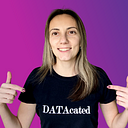Exploring the New Modern Data Stack with Zetaris and the Data Warrior
In a recent YouTube video, host Kate Strachnyi welcomed Vinay Samuel, the founder and CEO of Zetaris, and Kent Graziano, known as the “data Warrior” and the Chief Technical Advisor at Zetaris, to discuss the new modern data stack.
Vinay Samuel has been in the field of data management, data engineering, and analytics for 25 years. He has worked with several data startups that centralize and bring data together for data warehousing and data lakes. His company, Zetaris, takes a different approach.
“What Zetaris does is actually the total opposite,” said Samuel. “We have a thing called a networked data platform from Zetaris and what it does is enables you to join data and analyze it regardless of where it’s stored or where it lives across your network. We provide an automated data engineering and data virtualization platform to make it super easy to create that single point of access for all your enterprise data and across the cloud.”
Kent Graziano, the Data Warrior, has also been in the data space for over four decades. His expertise is in data architecture, data modeling, and data warehousing. He previously worked as the Chief Technical Evangelist at Snowflake and has now started his own consultancy, Data Warrior LLC.
“My especially was data architecture and data modeling and in the mid 90s that morphed into data warehousing,” said Graziano. “I got to meet Bill Inman and Claudia Imhoff and work with them and then Dan Linstead and the Data Vault world and just got really heavy into that and that eventually led me to Snowflake and the great product they put together.”
The new modern data stack is an important topic in the field of data management. It refers to the technology stack or system used to manage and organize data within an organization. Having a single point of access for all enterprise data can greatly improve efficiency and decision-making.
“What we’re seeing now is that data is everywhere,” said Samuel. “It’s in the cloud, it’s on-premises, it’s in data warehouses, it’s in data lakes, it’s in object stores. And the challenge is how do you bring all that data together so that you can actually use it?”
That’s where Zetaris comes in. Its networked data platform allows users to easily join and analyze data from any location within the organization.
“We provide an automated data engineering and data virtualization platform to make it super easy to create that single point of access for all your enterprise data and across the cloud,” said Samuel.
Graziano agreed that having a single point of access for data is crucial. “It’s about getting data into the hands of the people who need it to make decisions and to do their job better,” he said. “And that’s the key, it’s not about the data, it’s about the people who are using the data.”
The new modern data stack also allows for greater agility and flexibility in an organization. With the ability to easily access and analyze data from multiple locations, teams can make quicker and more informed decisions.
“In the past, we used to have to wait for data to be moved and transformed before we could use it,” said Graziano. “Now, with the new modern data stack, we can do things in real-time, we can do things at the edge, we can do things in the cloud, and we can do things on-premises. It’s all about agility and flexibility.”
The use of automated data engineering and data virtualization can also greatly improve the efficiency of data management processes.
“The challenge with data is that it’s always changing,” said Samuel. “New data sources are being added, data structures are changing, data is being updated. And so the key is to have a platform that can automatically adapt to all of those changes.”
Overall, the new modern data stack is revolutionizing the way organizations manage and utilize data. With the ability to easily access and analyze data from multiple locations and the use of automated data engineering and data virtualization, teams can make quicker, more informed decisions and improve efficiency in their processes.
“It’s about getting data into the hands of the people who need it to make decisions and to do their job better,” said Graziano. “And that’s the key, it’s not about the data, it’s about the people who are using the data.”
